The 7th Voyage Of Sinbad (1958)
Directed by: Nathan Juran
Written by: Ken Kolb, Ray Harryhausen
Starring: Kathryn Grant, Kerwin Mathews, Richard Eyer, Torin Thatcher
USA
AVAILABLE ON DVD AND BLU RAY
RUNNING TIME: 88 mins
AVAILABLE ON BLU-RAY AND DVD
On the island of Colossa, Sinbad and his crew encounter Sakurah the magician fleeing and losing a magic lamp to a Cyclops. Sinbad refuses his pleas to return to because Parisa, Princess of Chandra, is aboard, their coming marriage meant to secure peace between Chandra and Baghdad. The Caliph of Baghdad refuses to help the magician, so later that night, Sokurah shrinks the princess, enraging her father, the Sultan of Chandra, who immediately declares war on Baghdad. Sinbad and the Caliph give in to Sokurah, who explains that the eggshell of a Roc is needed for the potion that will restore Parisa, and it can be found only on Colossa. So Sinbad reluctantly sets sail….
I reviewed The 7th Voyage Of Sinbad seven years, partly as a response to the Sinbad series that was showing on TV. The latter wasn’t too bad really; fairly entertaining and to be honest about as good I as expected a trendy, modern interpretation of the great sailor to be, but me being me it sent me back to watch yet again the three Sinbad movies [of course there were others and some that were good such as Sinbad The Sailor and Captain Sinbad] that were produced by Charles H.Schneer and featured special effects by the great Ray Harryhausen, and the series just didn’t hold a candle to them. Forget the CGI or the jokey tone and the pointless sexual tension of the TV series; for me these old films, with their childlike innocence, adventurous feel and sense of wonder which for me they have never lost ever since I saw them as a young child, remain far more appealing. Even Harryhausen’s stop-motion [when an object is moved in small increments between individually photographed frames so it appears to move on its own] creatures have a sense of awe and even personality which most of today’s CG creations just don’t possess. And unlike some of the VFX show reels of today [which I do admit can be exhilarating too, I’m not too much of an old fuddy duddy I hope], his effects never detract attention from or take over from the story, even if the stories for these films were largely built around several planned set pieces. In any case, I decided to take the opportunity to expand my quite short older review and add a few new observations, though my view of The 7th Voyage Of Sinbad remains the same. Later Harryhausen creature-filled productions might be more complex script and effect-wise, but 7th Voyage’s youthful simplicity, by and large consisting of one thrill sequence after another separated by the mere minimum of chat yet still managing to provide just about enough character and plot development to make us care, remains hugely appealing.
This was to be Harryhausen’s first film in colour, and his first not to be set in the present day. He’d actually first thought of a Sinbad film in 1953, disappointed by other Sinbad pictures which went for the comedy and scantily clad females, and which often talked about things like monsters and magic but never showed them. In 1956 he revived the idea but his original treatment, not based on any specific Sinbad story but incorporating elements from some of them plus ‘The Odyssey’, would have been far too expensive to make with what would probably be a fairly low budget, and so some ideas were dropped, including a valley of diamonds, a giant frog and the Lord of Death. The climax originally featured two Cyclopes fighting rather than a Dragon battling a Cyclops, followed by narration telling us that Barani the genie would grow up to be a captain like Sinbad and marry a princess of his own. Early scripts also included things that would be omitted like giant rats, bat devils and sirens [though the latter are heard if not seen in the film]. It took Harryhausen eleven months to complete the animation sequences, while normal shooting only lasted four months, with location filming in Spain. On the last day of shooting, Kerwin Mathews [Sinbad] stayed in bed with a 107-degree fever. Schneer convinced him to come and do one final shot – which turned out to involve him being pelted with water and dead rats. The film was released to great commercial and critical success though the UK version removed some shots like close-ups of the Cyclops and the man roasting on a spit, plus the entire skeleton scene! The film is actually pretty violent for a 1958 ‘family’ movie. Five years later, producer Edward Small, who’d turned the project down, hired director Nathan Juran, Matthews and co-star Torin Thatcher for Jack The Giant Killer which was a virtual remake.
What I always find most striking about 7th Voyage right from the offset are not only the special effects but the sheer pace of the thing. It begins immediately with some spectacle as Sinbad and company arrive on an island and are almost immediately confronted by a large Cyclops pursuing a man carrying a lamp, but a great example of the economy of story telling from screenwriter Kenneth Kolb [though of course Harryhausen came up with the story outline and the creatures] is that it introduces most of the important elements and lays out the path that the tale will subsequently take. Then we relocate to Baghdad and, while we do get a couple of brief ‘romance’ scenes between Sinbad and Parisa, a considerable effort has been made to get all this ‘exposition’ stuff out the way as quickly as possible, though I always enjoy Harold Kasket’s amusingly smarmy Sultan and wish that we saw more of him. “If he can turn her into a contented woman, then he truly is a great magician”, he says as Sukorah announces he’s going to perform some magic involving Parisa’s handmaiden. Sakurah is desperate to return to Colossa to get his magic lamp, so he puts on this display of wizardry by creating a four-armed snake-woman [clearly the prototype for the Medusa in Clash Of The Titans] from Parisa’s maid and two snakes, which then does a dance before the tail starts so strangle the neck. Sokurah then, probably falsely, prophesies war between Chandra and Baghdad and is banished from the city, only to shrink Parisa down to a few inches high. Her father now threatens to sack Baghdad, so the voyage now has to happen, and from here on the film really is a series of thrill scenes, one ‘cliffhanger’ after another. Even on the ship, before we get to Colossa, Sinbad battles his mutinous crew, swinging around in cool fashion, and has to sail past the island of the Sirens, where those who don’t cover their ears are doomed [the high-pitched sound being hugely annoying and somehow giving the impression that it could convincingly kill someone].
Effective angles and even some early POV ‘shakycam’ enhance the forbidding nature of Colossa before the Cyclops returns, its best moment probably being when it uproots trees and crushes sailors with them, and the lamp is retrieved, but Sinbad is suspicious of Sokurah and refuses to let him have the lamp until he restores Parisa to her normal size – though Parisa being tiny soon proves to be a bonus. This is followed not long after by a baby Roc [giant two-headed bird] who is killed and eaten by some hungry sailors followed by the baby’s angry parent, a Dragon guarding the entrance to Sakurah’s underground lair where the magician has kidnapped Parisa [though it’s uncertain what he intends to do with her unless it’s just a way to get Sinbad to go there and be killed – this part of the plot is a little vague], and a living Skeleton, whose sword duel with Sinbad was later expanded by Harryhausen into the climax of Jason And The Argonauts. It required painstaking matching and Matthews does very well fighting ‘nothing’, a virtually new thing back then. The climactic Dragon/Cyclops battle is a bit short but then how time consuming would it have been to do? Cost meant that the Dragon only breathes fire, and none too convincingly, a couple of times before the fight, though it’s an impressive-looking monster anyway, and the Cyclopes, replete with cloven hooves, goat legs and horn, remain even more striking. Seeing as Harryhausen, used to black and white, had to rethink many of his in-camera techniques for this colour movie, the effects are still astounding for the period, while the slight jerkiness gives the creatures an uncanny feel. Harryhausen’s creatures always seem to possess weight and balance, gravity dictating their stance and movement – something you can’t always say about CG critters. And as I mentioned in my review of the 4k restoration screening of the film, I was now able to really appreciate the moving dolls created for the bits where the first Cyclops picks up and drops people.
Amidst all this almost non-stop action in this tight 88 minute film is Parisa going inside the Genie’s lamp, the interior all candy coloured, just like a child may expect it to be. The benevolent boy genie is rather different to the usual one in stories, a nice identification figure for young boys, though we don’t quite feel enough of his yearning to be free. The script does have some dialogue which may have seemed corny even in 1958, especially between Sinbad and Parisa, but the latter are enlivened by the playfulness and just ever-so-slightly coquettish nature [even when tiny] of the Princess, and – I dunno – such straight-to-the-point, childlike chatter is kind of fitting for a film like this, and it’s not like there’s much of it either. Matthews and Kathryn Grant do make you believe that they’re in love. And Matthews remains Harryhausen’s best Sinbad. You could say that Sinbad is a slightly bland hero, but he doesn’t need to be a complex character, he’s just someone you are behind and want to prevail, and Matthews is hugely likable. Of course it’s the ‘Boo Hiss’ villain Sokurah who dominates all the scenes he is in, and that’s exactly as it should be. Torin Thatcher is appropriately theatrical in the part, and when his eyes glare you do believe that he has great powers. One of his best moments is soon after we’ve first met him and he’s now safely on Sinbad’s ship away from the Cyclops. Asked why he couldn’t have used his magic powers to kill the beast, he replies; “I made a potion specifically for that purpose, but I couldn’t get the Cyclops to swallow it” with just a slight leer in his voice as he moves towards Parisa and she instinctively shrinks away from him. Great, to-the-point stuff without overdoing it.
The cast aren’t helped by rather poor post-dubbing which sounds tinny and isn’t even in synch some of the time, but the direction of Nathan Juran, not always a filmmaker of quality, moves things along so fast that we have little time to get bothered by such things. Nearly everything is appropriately bright and you even get some visual stylisation like those beautiful colourful cave interiors around Sukorah’s lair. And I doubt anyone would complain about another aural aspect, which is Bernard Herrmann’s terrific score. His main title piece perfectly conjures up a sense of the mystical Orient without actually sounding oriental. Oriental scales are often employed, though of course most of the score is there to back up the action and the monsters and that is does cleverly, from the mini concerto just for drums for the ship fight, to the note patterns mimicking the beat of the Roc’s wings, to the castanet piece for the skeleton duel. Much of the music is actually quite simple musically, often following similar two-note patterns, but his orchestration is astounding in its invention and doesn’t really date. Harryhausen’s fans are often in debate as to which of his movies is the best. The winner often tends to be Jason And The Argonauts, but there’s a case for saying that The 7th Voyage Of Sinbad could be his most purely fun effort, and I’d say that only the first two versions of The Thief Of Bagdad better it in terms of Arabian Nights-tinged pictures. In between gasping at the technical expertise, it always makes me feel like a child again every time I watch it, and we all need that, don’t we?
Rating: 









Expanded reviews of The Golden Voyage Of Sinbad and Sinbad And The Eye Of The Tiger Coming Soon!

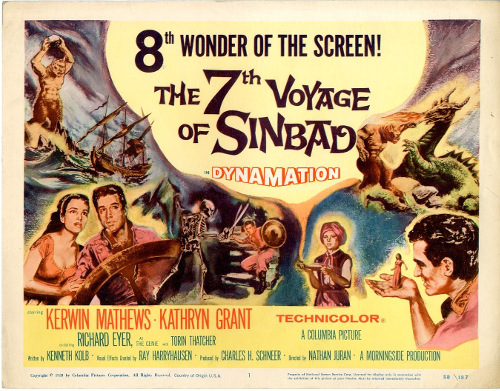
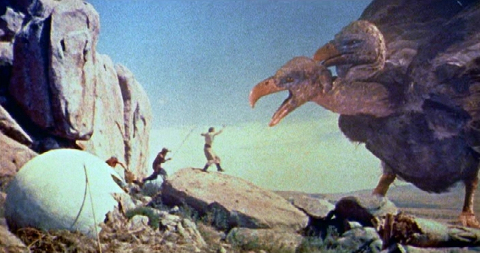


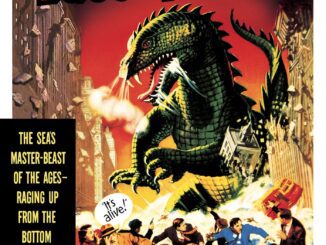
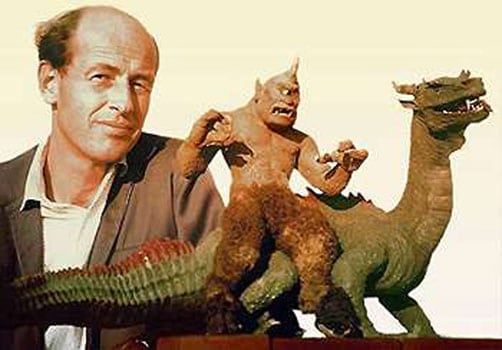
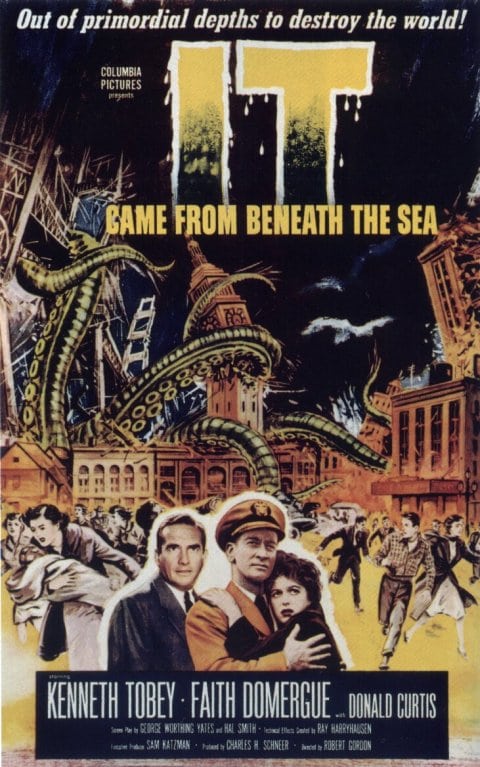
Be the first to comment